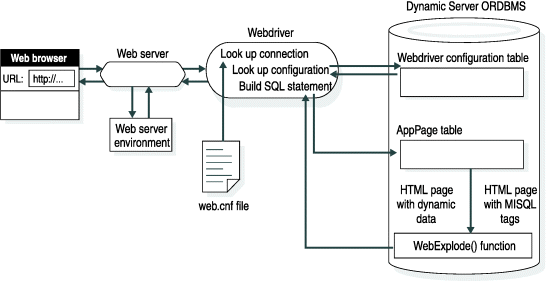Extensions to HCL OneDB
- Webdriver
- As a client application to your HCL OneDB database server, Webdriver builds the SQL queries that execute the WebExplode function to retrieve AppPages from the database. Webdriver returns the HTML resulting from calls to the WebExplode function to the web server.
- WebExplode function
- The WebExplode function builds dynamic HTML pages based on data stored in the database. WebExplode parses AppPages that contain OneDB Web DataBlade® module tags within HTML and dynamically builds and executes the SQL statements and processing instructions embedded in the OneDB Web DataBlade module tags. WebExplode formats the results of these SQL statements and processing instructions and returns the resulting HTML page to the client application (usually Webdriver). The SQL statements and processing instructions are specified by using SGML-compliant processing tags.
- OneDB Web DataBlade module tags and attributes
- The OneDB Web DataBlade module includes its own built-in set of SGML-compliant tags and attributes that enable SQL statements to be executed dynamically within AppPages.

When a web address contains a Webdriver request, the web browser makes a request to the web server to start Webdriver. Based on configuration information from both a file on the operating system file system (web.cnf) and Webdriver configuration information stored in a database, Webdriver composes an SQL statement to retrieve the requested AppPage and then executes the WebExplode function. WebExplode retrieves the requested AppPage from the web application table (stored in the database), executes the SQL statements within that AppPage by expanding the OneDB Web DataBlade module tags, and formats the results. WebExplode returns the resulting HTML to Webdriver. Webdriver returns the HTML to the web server, which returns the HTML to be rendered by the web browser.
Webdriver also enables you to retrieve large objects, such as images, directly from the database when you specify a path that identifies a large object stored in the database.
For more information, see the HCL OneDB Web DataBlade Module Application Developer's Guide.